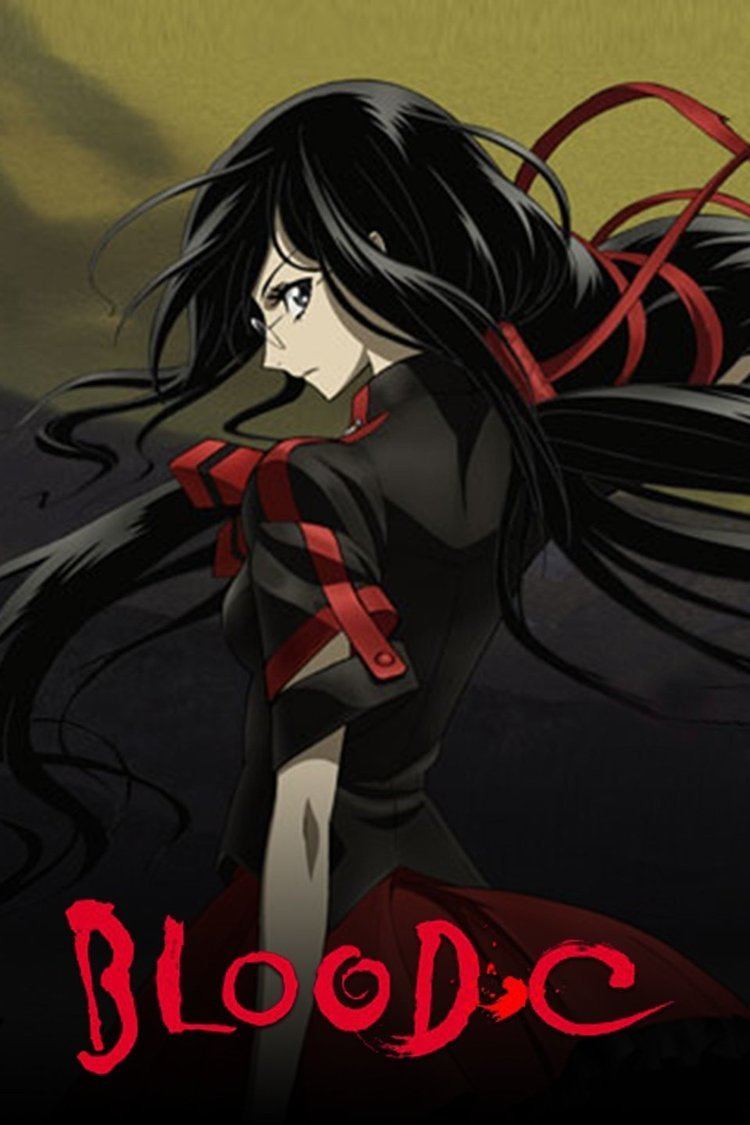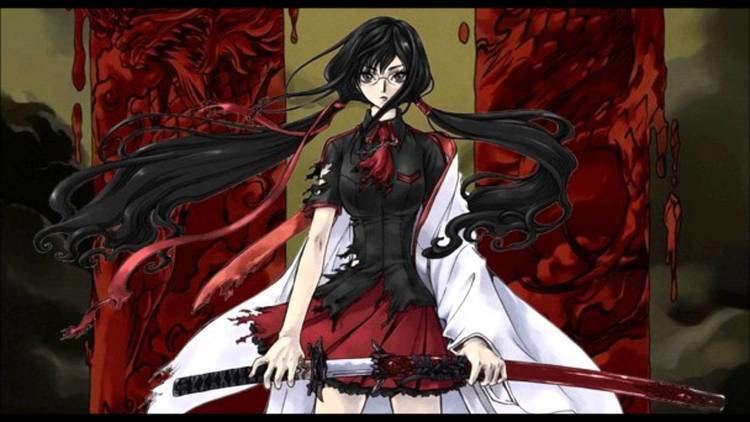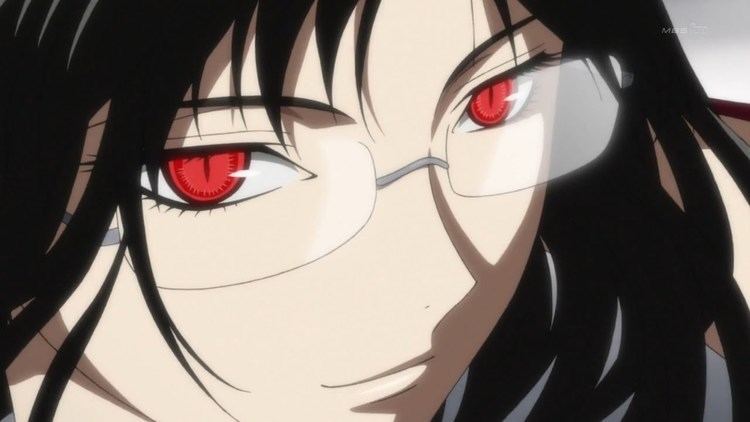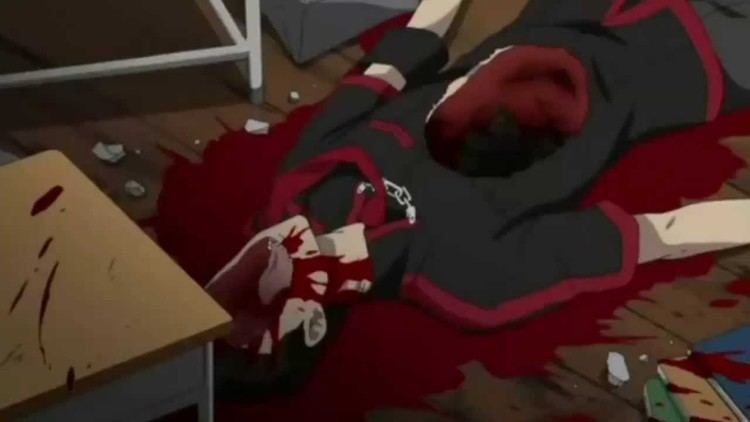Blood C
6.4 /10 1 Votes
Rate This Duration | 6.2/10 IMDb Director Naoyoshi Shiotani | |||||||||||||||||||||||||||||||||
 | ||||||||||||||||||||||||||||||||||
Release date June 2, 2012 Similar Boku no Pico, The End of Evangelion, Your Name | ||||||||||||||||||||||||||||||||||
Blood-C (Japanese: ブラッド-C, Hepburn: Buraddo-C) is a horror anime co-produced by studio Production I.G and manga artist group CLAMP. It is the second anime series in the Blood franchise following the 2005–2006 series Blood+. The original 12-episode series aired during 2011, with a movie Blood-C: The Last Dark releasing in Japanese theaters the following year. The anime was subsequently adapted into two manga, a 2011 novelization, a 2015 stage play set between the events of Blood-C and The Last Dark, and a live-action prequel set for release in 2017.
Contents
Blood-C focuses on Saya Kisaragi, an outwardly normal girl who serves as the shrine maiden to a country town; in reality, she is a skilled swordswoman charged by her father to defeat Elder Bairns, monsters who feed on human blood. As her battles grow more desperate and more people she cares for fall victim to the Elder Bairns, Saya begins finding faults in her reality, and eventually uncovers a disturbing truth about herself, the town and her surviving friends.

Blood-C was designed to share only thematic similarities with earlier Blood projects. CLAMP was brought on board to both design the characters and help create the scenario. It featured several new elements to the Blood franchise, such as being primarily set within a high school environment. The Elder Bairns were inspired by the Great Old Ones from H. P. Lovecraft's Cthulhu Mythos, and modeled after traditional Japanese monsters. Its bloody violence, a stylistic choice following the series' themes, resulted in censorship in Japan and eventual blacklisting in China. The series has received mixed to positive reviews from journalists.

Plot

Blood-C is set in an isolated rural town on the shore of Lake Suwa in Nagano Prefecture. Saya Kisaragi is the shrine maiden of the Shinto shrine run by her father Tadayoshi, and is outwardly a friendly and clumsy high school girl—her circle of friends include neighbor and cafe owner Fumito Nanahara; school friends Yūka Amino, twins Nene and Nono Motoe, class president Itsuki Tomofusa, the taciturn Shinichirō Tokizane; and Saya's schoolroom teacher Kanako Tsutsutori.
But while living a normal school life by day, Saya and her father spend the night defending the village against Elder Bairns, monsters who possess inanimate objects to stalk humans and feed on their blood. Saya's skills in the "art of the sword" enable her to defeat the Elder Bairns, but those capable of speech accuse Saya and the humans of violating a covenant dubbed "Shrovetide". Saya also encounters a talking dog which says it is here to grant someone's wish, and suffers from blanks in her memory and is pained by headaches whenever she tries to remember.
Saya's battles with the Elder Bairns become increasingly desperate as they begin attacking during the day, and both Nene and Nono fall victim, leaving Saya deeply hurt. Shinichirō eventually learns of Saya's burden and offers to help, but is later killed himself. An attack on Saya's school results in everyone but Saya and Itsuki dying before Saya can kill the attacking Elder Bairn. Saya later realizes that only her class and their teacher Kanako were present in the school. Due to the blanks in her memory and comments from the Elder Bairns, she begins questioning her identity and mission.
After the attack that kills Shinichirō, Kanako asks to see Tadayoshi's library, which contains information on the Elder Bairns. They find that the library is a fake, then Kanako confronts Saya with the living Nono, Nene and Shinichirō before forcing her to drink Elder Bairn blood. It is revealed that the town's entire population, including those close to Saya, were actors in an experiment organized by Fumito, and that Saya is actually an Elder Bairn in human form. She had agreed to take part in the experiment, swore an oath not to kill humans, and then was implanted with false memories of her past "human life," all with the goal of seeing whether her inner self could be altered so the oath could be broken. Whenever Saya began relapsing and remembering her past, Fumito used drugs and hypnosis to make her docile again, and all the Elder Bairns she faced were controlled by Fumito using her blood. Kanako had wanted to save Saya and prove the existence of Elder Bairns, suborning Nono, Nene and Shinichirō to help her.
Fumito, Itsuki and Yūka then confront them, with Fumito unleashing an Elder Bairn that brutally kills Nono, Nene and Shinichirō for their treachery. Saya saves Kanako from the Elder Bairn while killing it, but Kanako is then killed by Tadayoshi, revealed to be a human-Elder Bairn hybrid driven berserk by an overdose of Saya's blood given by Fumito. Saya—now back to her true self—is forced to kill Tadayoshi, and witnesses Fumito release an artificial Elder Bairn which slaughters the town's population before Saya kills it. Fumito's soldiers attempt to shoot Saya, but Itsuki sacrifices himself to save her as he had grown to love her. Fumito and Yūka—who participated so as to achieve political power with Fumito's help—escape on a helicopter. When Saya tries to stop them, Fumito shoots her. Recovering on the lakeside, Saya learns from the dog that her wish was to remain herself when in Fumito's experiment, and that she must now pursue her next wish. Saya sets off in pursuit of Fumito.
Characters
Production
Blood-C was a collaborative production between Production I.G and CLAMP. Production I.G is an animation studio which had created the Blood franchise with the 2000 film Blood: The Last Vampire, which was the studio's first attempt at an original in-house project. CLAMP is an all-female manga artist group made up of writer Nanase Ohkawa and artists Mokona, Tsubaki Nekoi, and Satsuki Igarashi. The main staff included both newcomers and people who had worked on previous entries in the Blood franchise. These included concept creator and co-writer Junichi Fujisaku, one of the original creators of the Blood franchise; and director Tsutomu Mizushima, whose most notable recent work was the anime adaptation of CLAMP's manga xxxHolic. Background artwork was created by Hiromasa Ogura, and setting artwork was created by Kazuo Kanpei of Kusanagi. 3D CGI was handled by Tsukamoto Mori. The music was composed by Naoki Satō, whose previous work included Sword of the Stranger. The opening theme "Spiral" was performed by Dustz, who worked hard to make the song a suitable addition to the Blood canon and incorporated both Japanese and French lyrics. The ending theme, "Junketsu Paradox", was sung by Nana Mizuki—the voice actress for Saya—who used the anime's story as inspiration and incorporated archaic phrases for the lyrics. The production team was dubbed "Project BLOOD-C TV".
When developing plans for Blood-C, it was decided to shift its setting based on positive feedback from the change of setting between Blood: The Last Vampire and the franchise's first anime series Blood+. The only elements to be retained were the first name of the main character, having a katana as her weapon, and the basic premise of her defeating monsters with that sword. The wish for the project to be distinct from earlier entries was what spurred the collaboration with CLAMP, which became a large part of the anime's marketing campaign. Fujisaku, when asked in an interview to describe his one creative ambition for the series, said that it was to fully expand and build upon the basic concept established in Blood: The Last Vampire. The choice of a school setting, the first of its kind to be featured in the Blood franchise, was chosen because Mizushima wanted to portray a school life for Saya. When asked, Mizushima did not find the change from his previous comedy anime-based turnout a barrier to his work, but did feel pressure when handling a project within the Blood franchise.
The scripts were written by Ohkawa and Fujisaku. While Ohkawa took charge of each episode's dialogue, Fujisaku handled fight sequences. Fujisaku pointedly avoided contributing too much to the dialogue as Ohkawa's writing had a very distinctive style, his alterations made only due to story inconsistencies. The series was composed in a way that gradually revealed the central mystery while pitting Saya against progressively stronger foes. The setting's intensely "normal" appearance was designed to make viewers feel uneasy as faults begin appearing in Saya's everyday life. According to Ohkawa, the main theme of the series was examination of the hero's role as a lonely protector of the innocent. Alongside this was the portrayal of Saya's seemingly normal life and now her role as the town's protector began intruding upon this everyday life. The final episodes were intended to evoke viewer sympathy for Saya due to the terrible ordeal she had been subjected to. The series broke from conventions of a hero-focused anime by portraying the relationships between Saya and those close to her in a very shallow way during the opening episodes. For the final few episodes, when the truth is revealed about Saya and her school life, the supporting cast were generally portrayed as "hateful" people that the viewers would wish to see die. So as to keep the series' twist ending a secret, the entire voice cast including Mizuki and Nojima—the respective voice actors of Saya and Fumito—were told nothing about the final episode's events. A different interview revealed that each cast member were only given the scripts for three episodes at any one time to preserve secrecy. The subtitle of each episode was drawn from the Japanese poetry anthology Ogura Hyakunin Isshu. The series made regular use of bloody violence, which was exaggerated to distance viewers from the show's horrific elements. Despite this, the director said the show was not deliberately focused on bloody violence.
The design of the main cast was handled by CLAMP. According to Mizushima, the team wanted to portray Saya in a far more human way than her previous incarnations, ending up creating a character more human then even the true human characters. Saya's character as a long-haired, song-singing meganekko (girl in glasses) almost entirely created by CLAMP. Due to the stark differences between this version of Saya and previous versions, Fujisaku did not used her original surname "Otonashi", so viewers could clearly distinguish Saya's portrayal from previous entries. When deciding upon her strength, Mizushima decided to use Hit-Girl from the movie Kick-Ass as a role model, making Saya stronger than Hit-Girl while also putting her into a high school environment. The animation character designer was Kazuchika Kise, who worked on Blood: The Last Vampire. Yasuomi Umetsu directed and worked on the storyboard for the game's opening along with Kise. A key part of the opening was a layer of blood peeling away from Saya's naked form. While compared by many to the opening of Ghost in the Shell, Umetsu said that it represented Saya's personal evolution during the course of the show. The Elder Bairns were designed by Tomohiro Shinoda. They were initially conceived by Ohkawa as Japanese versions of the Great Old Ones, figures from the Cthulhu Mythos created by H. P. Lovecraft. While some elements remained from the initial concept, the Elder Bairns' physical forms as faced by Saya were inspired by yokai from Japanese folklore at Mizushima's insistence—this design choice was decided upon after Jizo finished storyboarding the fight against the first episode's Elder Bairn, which was modeled after a Jizo statue. This initial concept was expanded upon by Mizushima, Ohkawa and Fujisaku. The disguised form of the Elder Bairn from the fifth episode was based on train carriages from the Kamikōchi Line in Nagano Prefecture that Mizushima had enjoyed traveling on as a boy. The Elder Bairn from the ninth episode was intended for the second episode, but the staff felt it was too strong to appear so early, so it was shifted to a later episode. All the Elder Bairns were designed to give the impression of a "vivid, flesh-and-blood texture".
Broadcast
Blood-C was first announced in March 2011, with its core staff and its approximate air date in July. The series began broadcasting on July 7, 2011. While scheduled for June 7, its late night slot meant that the first episode's actual broadcast was on July 8. In celebration of the anime's release, an autographed copy of the first episode's script was offered in a competition through the anime's official website. A special web radio series featuring actors from the show also began broadcast in July alongside the series. Dubbed "Blood-R", it ran for eleven episodes. It first began broadcasting on Mainichi Broadcasting System (MBS) on July 7 and Tokyo Broadcasting System (TBS) on July 8. Several episodes were repeated during the original broadcast in a three-day successive broadcast in August. Its twelve-episode run ended on September 30, 2011. During the original broadcast, scenes were Saya's friends or other humans characters were killed by the Elder Bairns—the process of which invariably involved extensive blood and gore—were censored with areas of light and darkness. The deaths of Elder Bairns and mild erotic elements during a bathing scene with Saya were left uncensored.
During its original run, it was broadcast simultaneously in North America, the United Kingdom, Canada, Australia, New Zealand and South Africa through the Western branch of Niconico. In addition to this, the series broadcast on Chubu-Nippon Broadcasting from July 13, and Kumamoto Asahi Broadcasting RRK station from July 31. Blood-C would later debut on Wowow in 2013: Episodes 1 to 10 were broadcast back to back on September 22, while the final two episodes broadcast on September 29. In 2015, Niconico's Japanese channel ran a marathon broadcast of all twelve episodes starting from June 28. Blood-C was one of three anime cited—alongside Highschool of the Dead and Terror in Resonance—in a warning given by the Chinese Ministry of Culture to video streaming sites due to the series high violence. Blood-C was later put on a blacklist by the Ministry of Culture alongside 37 other anime and manga series, prohibiting its physical and online distribution in mainland China.
Home media
The series' Blu-ray and DVD releases were handled in Japan by Aniplex. The series released in six volumes between September 28, 2011 and February 22, 2012. The series' English dub and North American licensing was handled by Funimation. A box set containing the whole series released for Blu-ray and DVD on January 22, 2013. In Australia, the series was licensed by Madman Entertainment, releasing as a box set for DVD and Blu-ray on April 17, 2013. In Europe, the series was distributed by Anchor Bay Entertainment through Manga Entertainment. It released as a box set on DVD and Blu-ray on June 10, 2013.
Films and stage play
A theatrical movie was announced shortly after the anime series, acting as a conclusion to the story of Blood-C. Titled Blood-C: The Last Dark, it released in Japanese theaters on June 2, 2012. A live-action prequel set during the military regime of pre-World War II Japan, titled Asura Girl: Blood-C Another Story, is set for release in 2017.
A stage play titled Blood-C: The Last Mind was produced by Nega Design Works, being staged at the Setagaya Public Theater between July 2 to July 5, 2015. The stage play was directed by Shutaro Oku, who also created stage plays based on Persona series, and written by Fujisaku. Set between the events of Blood-C and The Last Dark, it expands upon Fumito's backstory.
A novelization of the series was written by Fujisaka, released on October 4, 2011 by Kadokawa Shoten. A manga adaptation of Blood-C was announced alongside the anime. Adapted by manga writer and illustrator Ranmaru Kotone, it debuted in the June issue of Monthly Shōnen Ace on May 26. The manga ended in August 2012, having run for over a year. The manga was released in four volumes between July 26, 2011 and November 21, 2012 by Kadokawa Shoten. The manga covered the events of the whole story of Blood-C, from the anime series to the feature film. The manga was licensed for the West by Dark Horse Comics. Its four volumes released between March 6, 2013 and December 30, 2015.
A second spin-off manga series titled Blood-C: Demonic Moonlight began serialization in the debut issue of Newtype Ace in September 2011. It was written by Ryo Haduki. Set in post-war Japan in 1946, the story of Demonic Moonlight acts as a prequel to Blood-C. The manga ended in May 2012. It was released in two volumes on December 17, 2011 and May 23, 2012. As with the series' manga adaptation, Dark Horse Comics. The two volumes released on and May 18 and August 3, 2016.
Reception
During its opening week, the first DVD/Blu-ray volume failed to reach a high position in the charts against many anime and live-action releases, selling only 727 copies according to Oricon. In contrast, at its release in the United Kingdom, the Complete Series release reached #4 in the anime charts. At the Reaper Award awards show, Blood-C was awarded the 2013 for "Best Animation".
Richard Eisenbeis of Kotaku praised the character and Elder Bairn designs, and also enjoyed the questions the anime posed about where Blood-C fitted in both the overall Blood franchise and the works of CLAMP. He was more mixed about the odd justoposition of innocent school life with the high violence of Elder Bairn encounters. He was also unsure about the ending, saying it tidied up the series' mysteries but required watching the movie to understand the story. He ended his review by calling Blood-C "a beautifully drawn show with excellent action and a legitimately compelling mystery".
Bradley Meek, writing for THEM Anime, gave the series 3/5 stars. He praised the way the series maintained its horror-based atmosphere in between the action sequences. He greatly enjoyed the horror and action aspects, but felt that the character-driven segments in early episodes threatened to drag down the whole experience due to mundane content and poor characters. Talking about the anime's second half, he said that it drastically altered the pace and content to the point that viewers might be put off with its conscious bending of the rules of handling characters and viewers alike—Meek was ultimately angry at the series' brutal ending, but it also left him eager to see its movie conclusion.
Anime News Network's Carlo Santos gave the subtitled version a score of "B-" and the dubbed version as score of "C+". He found the darker elements hidden so well in early episodes that it made the series boring to watch, and that the ending would divide opinion due to its drastic alteration of how events in the series played out and its discussion of both horror tropes and the standard elements of the Blood franchise. The action scenes came in for regular praise for their choreography and many monster designs, but the school life segments were seen as boring and overly slender character designs. Santos unreservedly praised the music's quality and recurring melodies despite calling the opening and ending themes "typical angst-ridden rock numbers". He called the English dub "understated (but not emotionless)", finding that it reinforced the overall atmosphere and only suffered due to the original writing.
References
Blood-C WikipediaBlood-C IMDb
